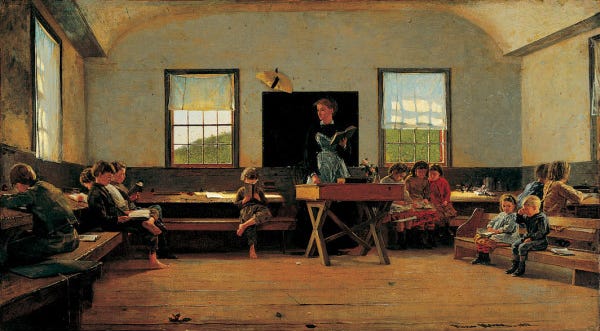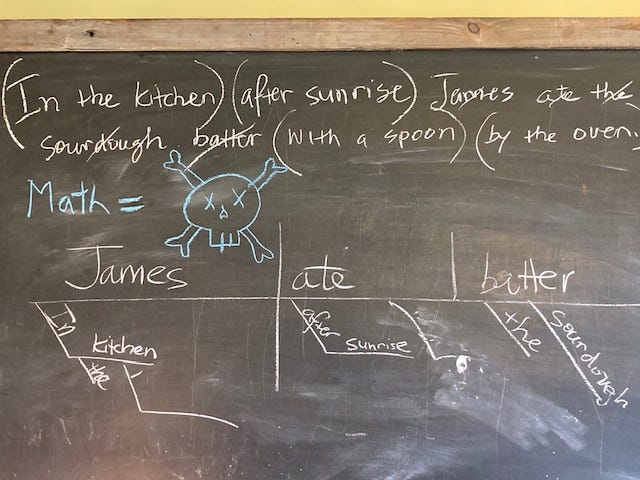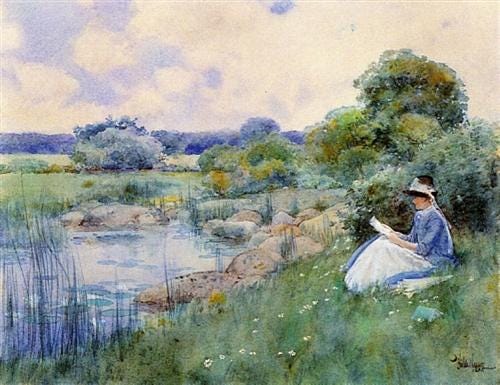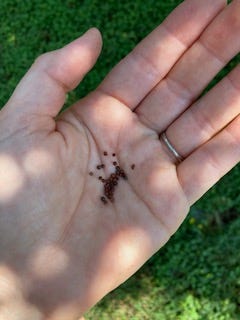
Last Friday, amidst streamers and good friends, we celebrated the final day of our ninth year of homeschool. If you had told me when I was a newlywed/new college graduate that I would be homeschooling my six children two decades hence, I would have had so many questions. In fact, when I was in college and informed people what my major was (English) they (inevitably) asked, “so whaddaya gonna do with that…teach?” To which I icily answered, no. Joke’s on me, I guess.
Long story short, as a 20-year-old, I had no plans to homeschool. 20 years and six kids later, here we are, in the throes of one of the most fascinating and difficult challenges of my life. Below are nine things I’ve learned along the way—hopefully you can take a small idea or two from my experience and apply it to your own life, whether you homeschool or not.
Lesson #1 — Every Homeschool is Unique
When I consider all the families I know who homeschool, I have never met two who approach it in the same way. Sure, there may be a bit of overlap in curriculum choice or educational philosophy, but I love seeing the unique choices each of my friends makes in how they choose to educate their children.
Some friends join co-ops and learn with a large group once (or more) each week. Others give their children piano and violin lessons, and attend concerts or the opera together. Some join sports teams or learn a skill like archery. Some teach their children to garden or to hunt or fish.
Yes, you can glean inspiration from those around you who homeschool, but your home and your strengths and your children are unique. It is beautiful to see the differences in how we educate our children, as it is to see a well-tended garden with all its variety in trees, plants, and flowers. A garden with only one variety of rose would be a dull one indeed.

Lesson #2 — The supplies you need are surprisingly simple
Ah, the allure of a beautiful curriculum! While I have nothing against a wonderful curriculum, it can be (very) easy to forget that the tools we need to teach our children are simple, inexpensive, and readily available. Here are my top four supplies:
Good Books — physical, well-written, beautiful books. Own them, read them, love them, check them out from the library, give them as gifts to your children. Books are foundational to education.
Pencils — pencils for writing and the best colored pencils we’ve tried. No, I don’t think it’s a good idea for children to learn from a screen starting in 2nd or 3rd grade (which seems to be the norm in many schools here in the United States currently). Writing by hand is a “neurobiologically richer process” than typing or tapping; why rob my children of the opportunity to learn one of the most “complex motor skills our brains are capable of?”1
Paper — If you’re writing by hand, you need (a lot of) paper. Lined paper, white paper, all the paper. Buy it in bulk.
Time Spent Outside — There is no science curriculum or textbook (especially for those elementary years!) better than simply going outside and observing what is around you. Charlotte Mason said it best:
There is no sort of knowledge to be got in those early years so valuable to children as that which they get for themselves of the world they live in.2
Lesson #3 — Involve other Teachers
This can take so many different forms. My husband, for example, is teaching my oldest two (ages 15 and 13) a class on the Constitution. He does so in the evenings, and it has been great to outsource that to him since he knows it so well. He also teaches grammar to my oldest four through sentence diagramming which I think is great fun. (Some of my children love it, some…do not.)
Sometimes involving other teachers can be more organic. When my mother came to visit a few months ago, she would sit down every morning with my six-year-old son and a few of his school-books, and read aloud to him. Those are precious memories for me, and I’m sure they will be for him as well. Yes, it takes a great deal of time in those early years to read to and sit with the youngest students while they are learning to write and read. But those years are like the newborn weeks; they are so very short. Soon enough, that same little six-year-old will be reading all of his books on his own and won’t need my help and observation for every assignment.
Involving other teachers can also be online classes or co-ops. This nature study class is a live class taught every two weeks, and a wonderful way to stay accountable with a subject that can sometimes fall through the cracks.
Be creative—involve your husband if he can teach your children something he is passionate about. Or simply ask a family member to read aloud to your younger students once a week. Perhaps a neighbor is a master gardener and is willing to teach your children the basics of composting or tending a small vegetable garden. There are so many ways to include other teachers for our children, even in a home-based setting.
Lesson #4 — Teach your Children to Cook (Breakfast)
A few years ago I decided to give each of my (older) children a day of the week to make breakfast for the family. It has been wonderful for everyone: I have a bit more time a few days a week to get our morning started with chores (and perhaps even some personal reading!), and my children are learning to cook all sorts of breakfast delights. Best of all, cooking breakfast is the chore they love more than anything else.
Educating our children includes a lot of reading and writing, yes. But if education is the passing on of a culture from one generation to the next, teaching children to cook shouldn’t be neglected.
Lesson #5 — Be cautious of Information Overload
The homeschool world has grown significantly in the last 20 years, and along with that growth there has been an explosion of information on All The Ways You Can Possibly Homeschool. There is a very real temptation to continually listen to podcasts and read blogposts/books about education, while never applying that knowledge to action. Often we do not need more information, we simply need to act based on what we already know.
Lesson #6 — Don’t Homeschool Alone
No, this doesn’t mean you must join a co-op (although those—I’ve heard—can be wonderful). What this means (for me) is this: have a friend or two you can meet with or chat with on the phone about everything: problems, doubts, curricula, ideas, etc. The last-day-of-school party I hosted with a friend and her children is a great example of this; it was a wonderful day of food, games, and camaraderie. Not only did our children have an opportunity to be together, but my friend and I had a thoughtful conversation about how our year of schooling had gone.
Homeschooling together can also mean reading and thinking through educational philosophy together. I am reading through Charlotte Mason’s six volumes with another friend (I mentioned this in my essay about Book Clubs for Two); we meet every month or so to discuss a few chapters at a time and it has been very life-giving and inspiring. No, we don’t physically homeschool our children together at the same time and place, but we are digging deep into what we want our days to look like and what sort of mothers and teachers we aspire to be.
This need for community isn’t only for homeschooling mothers—modern life as a mother can be deeply isolating. Families are spread far apart, friends are rarely neighbors. We need to find—or, more accurately, create—communities wherever we are. This takes effort, but is very much worth it.
Lesson #7 — Your example of learning is perhaps the most important aspect of your homeschool
While I can’t read every single book I assign to my children, I try to read many of them so that I can have better, more informed conversations with them about what they’re reading/learning. I also know this: that if I tell my children learning is important, but they never see me taking my own learning seriously, they will know that I don’t really mean it.
My example of reading — so that my children can see me! — is vital to the success of our homeschool. Read where your children can see you, and they will know that you mean what you say when you tell them that time spent reading/thinking is important. (Joel Miller recently wrote a great piece about how a parent’s example as a reader is the solution for the collapse of literacy, and I wholeheartedly agree).
Lesson #8 — Don’t take Yourself too Seriously
Enjoy this time with your children. No, learning will not always be fun or even pleasant, but try to stay light-hearted and cheerful. I have spent far too many school days barking at my children like a drill sergeant to get them to do their reading/piano/math/chores. I wish I could go back and re-do many of those mornings! No one learns well when a mother is critical, exacting, and joyless.
Lesson #9 — Take the Long View
This is not the only opportunity your children will have to learn, to grow, to fall in love with reading or math or music. Life is long. They will have other experiences with other teachers, schools, settings, where they can flourish. Right now you are planting a lot of good seeds, some of which will grow and develop while they are living with you, others which may not grow until they’re grown and gone. (This is echoing Cindy Rollins, and I trust her! She has seen many children through the homeschool process). We can’t force growth, but we can plant a seed.
The creations of a thousand forests is in a single acorn.
-Ralph Waldo Emerson
Are there any lessons you would you add to this list? I’d love to hear them!
Jonathan Lambert, “Why writing by hand beats typing for thinking and learning,” NPR, May 11, 2024, https://www.npr.org/sections/health-shots/2024/05/11/1250529661/handwriting-cursive-typing-schools-learning-brain
Charlotte Mason, Home Education (Living Book Press, 2017), 61.







Great advice. I home schooled 3 boys over 16 years and these things are truly beneficial.
"Don't take Yourself too Seriously" and "Take the Long View" were my favorites. I am so thankful I was able to homeschool, it has been one of the highlights of my life.
These are all so great! Love thinking about how these things connect to our homeschooling.